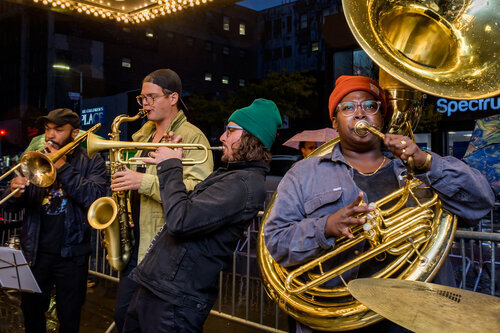Brooklyn Blows: Inside Brass Band Music’s Big Moment
Forget the guitar, bring on the brass.
Brass bands—ensemble groups dominated by horn sections and often accompanied by percussion—will be sounding out around town at multiple festivals in October. Bands ranging in size from a few horns to those with as many as 30 players plus dancers will perform in traditional New Orleans second line style, yes. But they also pull from a variety of genres.
New York, it turns out, has an incredible diversity of brass bands with their own unique flavor. And this month there are two separate festivals that celebrate its various expressions.
“New Yorkers are out on the street, and you’re hearing sounds from everywhere and that inspires you to like, make your own music,” says Sara Valentine, a majorette and ambassador of the 15th annual HONK! NYC festival, held October 18-24 at various venues. The virtual and IRL festival features 30 bands playing in a variety of brass styles, taking on human and environmental rights issues, and performing in art parades and original scores.
Although some local bands performing at HONK (including Demolition Brass Band, Escalation Horns and the all-female Brass Queens) lean into tradition, New York’s brass bands are a reflection of the city’s vast musical landscape. “Whenever I hear original pieces created by my contemporaries and by my younger colleagues… it’s music that’s inspired by Cuban influences, by Haitian influences, by Brazilian, by Eastern European [influences. Punk rock, Afrobeat, klezmer, typical pop or disco punk,” Valentine says. “The new brass scene is at its best when it’s forging new territory and crossing genres.”
HONK! NYC was founded in 2007 by members of the Hungry March Band as a local version of the global HONK! United network, and provided a launch pad for a growing community of players. Among those HONK-grown groups is brass collective/nonprofit L Train Brass Band, which is having its own festival on October 16. Brasswick, now in its second year, will go down at 3 Dollar Bill in East Williamsburg. Operating with assistance from the Brooklyn Arts Council, Brasswick is a five-band showcase of the diversity of Brooklyn’s brass scene.
“Brasswick is kind of a representation of the community itself,” says festival organizer and saxophonist Ally Chapel. “New Orleans brass band music is very important here and a primary thread … but each of these brass bands actually bring something a little different.”
Brasswick’s lineup will include the more traditional L Train, Afrobeat and Ethio-jazz influenced Dingonek Street Band, Afro-Brazilian styled No Small Money Brass Band, Afro-Cuban Nation Beat—all local groups—as well as Colorado’s Guerilla Fanfare. The event will have two local food vendors, a DJ and comedians as hosts, with proceeds benefiting New Orleans nonprofit Feed the Second Line. The event is donation based, with vaccination required for all entrants.
“What [Brasswick] did was address a need to bring a brass identity to that community…where young professionals or creatives are able to afford to live. So they basically built a scene around their neighborhood,” says Valentine, who booked L Train one of its early gigs at the Mermaid Parade in 2017. “I was so impressed with the community spirit of that event, both amongst the players, and then amongst the surrounding neighborhood.”
Decades of NYC brass
L Train Brass Band and its various offshoots are following a decades-long tradition in the city that began with Hungry March Band (founded in 1997) and Rude Mechanical Orchestra (2004). As those groups evolved and gained fans, new groups appeared: Frank London’s Klezmer Brass All Stars, Funkrust Band, Maracatu NY, Lucky Chops, Breakdown Brass Band and many more. Some of the current crop can trace their origins to Slavic Soul Party, a Balkan brass/jazz band with a nearly 20-year residency at Park Slope stalwart Barbes. Chapel estimates that there are 50 brass groups across the five boroughs and musicians are drawn to the genre’s distinct sounds and communal vibe.
“Brass music is fun, it’s party music. It’s uplifting, it’s loud, it’s in the street, it gets people together. It pulls them from across the street and down the block,” Chapel says. “It’s a very visual thing on the street; so the more you see, the more that idea gets passed around, the more people want to do it.”
Brass band participation and creation especially exploded over the past year and half, when the pandemic and Black Lives Matter pushed people into the streets. “People were coming out of lockdown, there are protests happening right and left, the best place to be … is in the street. So something that was already growing and swelling triples,” Valentine says. Five or six new bands came out of the L Train Brass family alone last summer, Chapel notes.
As the brass band community continues to grow, Chapel sees events like Brasswick as “a real opportunity to pay and honor and respect all the bands that paved the way…and just give back as much as we can.”
